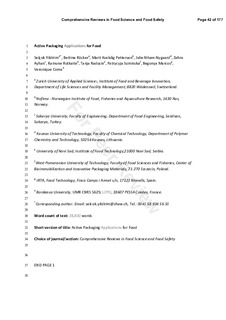Active packaging applications for food
| dc.contributor.author | Yildirim, Selcuk | |
| dc.contributor.author | Röcker, Bettina | |
| dc.contributor.author | Pettersen, Marit Kvalvåg | |
| dc.contributor.author | Nilsen-Nygaard, Julie | |
| dc.contributor.author | Ayhan, Zehra | |
| dc.contributor.author | Rutkaite, Ramune | |
| dc.contributor.author | Radusin, Tanja | |
| dc.contributor.author | Suminska, Patrycja | |
| dc.contributor.author | Marcos, Begonya | |
| dc.contributor.author | Coma, Veronique | |
| dc.date.accessioned | 2019-03-04T07:47:14Z | |
| dc.date.available | 2019-03-04T07:47:14Z | |
| dc.date.created | 2018-04-04T19:54:05Z | |
| dc.date.issued | 2018 | |
| dc.identifier.citation | Comprehensive Reviews in Food Science and Food Safety. 2018, 17 (1), 165-199. | nb_NO |
| dc.identifier.issn | 1541-4337 | |
| dc.identifier.uri | http://hdl.handle.net/11250/2588368 | |
| dc.description.abstract | The traditional role of food packaging is continuing to evolve in response to changing market needs. Current drivers such as consumer's demand for safer, “healthier,” and higher‐quality foods, ideally with a long shelf‐life; the demand for convenient and transparent packaging, and the preference for more sustainable packaging materials, have led to the development of new packaging technologies, such as active packaging (AP). As defined in the European regulation (EC) No 450/2009, AP systems are designed to “deliberately incorporate components that would release or absorb substances into or from the packaged food or the environment surrounding the food.” Active packaging materials are thereby “intended to extend the shelf‐life or to maintain or improve the condition of packaged food.” Although extensive research on AP technologies is being undertaken, many of these technologies have not yet been implemented successfully in commercial food packaging systems. Broad communication of their benefits in food product applications will facilitate the successful development and market introduction. In this review, an overview of AP technologies, such as antimicrobial, antioxidant or carbon dioxide‐releasing systems, and systems absorbing oxygen, moisture or ethylene, is provided, and, in particular, scientific publications illustrating the benefits of such technologies for specific food products are reviewed. Furthermore, the challenges in applying such AP technologies to food systems and the anticipated direction of future developments are discussed. This review will provide food and packaging scientists with a thorough understanding of the benefits of AP technologies when applied to specific foods and hence can assist in accelerating commercial adoption. | |
| dc.description.abstract | Active packaging applications for food | |
| dc.language.iso | eng | nb_NO |
| dc.subject | Antimicrobial packaging | |
| dc.subject | Active packaging | |
| dc.subject | Antioxidant releaser | |
| dc.title | Active packaging applications for food | nb_NO |
| dc.type | Journal article | nb_NO |
| dc.type | Peer reviewed | nb_NO |
| dc.description.version | publishedVersion | |
| dc.description.version | acceptedVersion | |
| dc.source.pagenumber | 165-199 | nb_NO |
| dc.source.volume | 17 | nb_NO |
| dc.source.journal | Comprehensive Reviews in Food Science and Food Safety | nb_NO |
| dc.source.issue | 1 | nb_NO |
| dc.identifier.doi | 10.1111/1541-4337.12322 | |
| dc.identifier.cristin | 1577529 | |
| dc.relation.project | Nofima AS: 201704 | nb_NO |
| dc.relation.project | Norges forskningsråd: 262306 | nb_NO |
| dc.relation.project | Nofima AS: 201306 | nb_NO |
| dc.relation.project | Norges forskningsråd: 225351 | nb_NO |
| dc.relation.project | Norges forskningsråd: 262303 | nb_NO |
| dc.relation.project | Nofima AS: 201703 | nb_NO |
| cristin.unitcode | 7543,3,4,0 | |
| cristin.unitname | Trygg og holdbar mat | |
| cristin.ispublished | true | |
| cristin.fulltext | original | |
| cristin.fulltext | postprint | |
| cristin.qualitycode | 1 |
Tilhørende fil(er)
Denne innførselen finnes i følgende samling(er)
-
Artikler / Articles [1429]
-
Publikasjoner fra CRIStin [2492]
